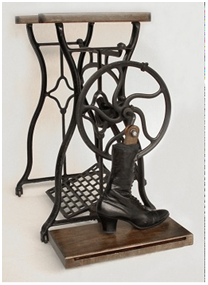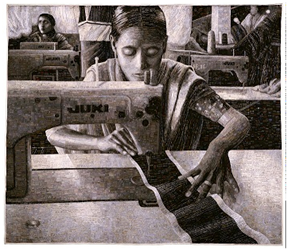New York City Electroacoustic Music Festival
DiBenedetto demonstrates that the sewing machine, manipulating textiles, will make music. Agnew shows that little cloth tags can be assembled to create a portrait of beauty's creation, and beauty itself.
[avatar user=”Jean Ballard Terepka” size=”96″ align=”left”]Jean Ballard Terepka, Music Reviewer[/avatar]In a somewhat removed second-floor alcove of the Abrons Arts Center in Lower Manhattan, at a short distance from the Experimental Theater, were two interactive multimedia installation pieces by electroacoustic composer and kinetic sculptor, Gary DiBenedetto. Together, Fifteen Words a Minute and The Little Woman were presented under the title Tools of Exploited Women, a mini-exhibit in the New York City Electroacoustic Music Festival (June 2-8, 2014).

pedal-powered sewing machines
These works combine DiBenedetto’s interests in “auditory experimentation, carpentry, antique collecting and sculpture studies” (http://www.GarydiBenedetto.com) and make political statements about the ways in which technological advances in industry at the turn of the last century led to the political and economic exploitation of women workers. Originally designed to liberate workers and artisans from time-consuming tedium, the machines DiBenedetto examines ended up creating economic profit and human devaluation. The noise and pace of both manual typewriters and pedal-powered sewing machines the two pieces of equipment featured in this NYVEMF mini-exhibit increased work productivity by requiring the complete abandonment of the individual identity of human touch and the flexible, organic control of hand motions in writing and sewing. Typists, tailors and seamstresses became increasingly valued only in as much as they could become their machines’ agents; and as the machines themselves were valued as profit-generators, their operators, almost all women, became more and more susceptible of exploitation.
DiBenedetto wired both the Fifteen Words a Minute typewriter and the Little Woman sewing machine acoustically so that the viewer/participant, after putting on headphones, could create and listen to the machines’ music. The typewriter keys each had their own “note” so the “music” generated was made up of typed texts’ chance melodies, the rasp of the carriage return, and the typist’s rhythm. The sewing machine’s “music” consisted more of the two-sound whir and plonk of the foot pedal, and its rhythm. The typewriter made a more complicated musical instrument, capable of many varied sounds, but the sewing machine was the more interesting and meaningful acoustical sculpture.
In The Little Woman, DiBenedetto attached a single slender and elegant late nineteenth century brown leather, black button-up boot to the pedal: as the dissociated singleton of a pair, no longer inhabited, a disarticulated foot, ghoul and ghost, the boot successfully conjured up all the seamstresses who had ever worked at that machine and its companions. The music that The Little Woman viewer/participant made, amplified and then contained in headphones, was both newly present and an echo of all the past sounds the long-ago seamstresses themselves had created and heard.
The success of The Little Woman was two-fold. First, as a music maker, it explored tensions, contributions and contradictions among machine-generated and human-generated sounds in the creation of music; this examination of the core relationship between electronically generated and preserved musical sound and “traditional” music was one of the many recurrent themes of the New York City Electroacoustic Music Festival as a whole. Second, as a mobile sculpture about sewing, it joined a varied and eloquent population of highly political works of art whose subject is exploitation in mass manufacturing and whose vocabulary is the history of textiles.
Textiles are symbolically rich as a subject for the discussion of many subjects ranging from artistic creation to political exploitation. Cloth itself is a particularly pure example of creation: the transformation from threads to textile is a close cousin to ex nihilo manufacture of something from nothing. Clothing from cloth exemplifies a subtler movement of creation, reflected in our very language: we marvel at fabrications of all sorts.
Textile mills and clothing factories from the newly industrialized nineteenth century through to the current twenty-first century have turned the delicate marvel of thread and textile creation into polluting death houses. Mills and factories damage their workers, both causing and confirming their expendability.
This was the awful tragedy of the 1911 Triangle Shirtwaist Factory Fire that claimed the lives of hundreds of Italian and Jewish immigrant girls and young women in downtown Manhattan: these seamstresses who turned cloths into clothes were expendable.
The brown boot of The Little Woman is the kind of boot the Triangle factory girls wore.
DiBenedetto’s Little Woman shares much in common with Portrait of a Textile Worker, a remarkable art tapestry by Therese Agnew currently on display at the Museum of Art and Design at 2 Columbus Circle in New York City.
Public sculptor and textile artist Therese Agnew completed her monumental art quilt, Portrait of a Textile Worker, a 7′ by 9′ fabric portrait of a Bangladeshi textile worker made of hundreds of thousands of clothing labels in 2005. As Agnew reported in 2008, the portrait was “based on a 2002 photograph of a young textile worker in Bangladesh taken … during an unauthorized visit to the factory.” For the project, Agnew collected hundreds of thousands of tiny garment and clothing tags from thousands of people, thereby creating a work of art with communal characteristics. She used individual tags and their texts for gradation, line creation, blocking and contrast. “From twenty feet away,” she wrote in the Museum of Art and Design second lives: remixing the ordinary catalog, “The composition is a representational image of a remote place. As you move closer, the illusionistic devices dissolve into labels as intimately familiar as your own clothes.”

Therese Agnew Portrait of a Textile Worker
The image of the anonymous textile worker, created from teeny little rectangular commercial product identifiers, is amazingly unique and accessible: the woman in the portrait, representing all her fellow seamstresses, is unforgettable as both paradigm and individual. The panel whose edge she seams, for all its straight linearity, undulates fluidly; the viewer can feel its movement under her hand and can hear the whir of her machine.
Exactly a century after the New York City Triangle Factory fire, news of horrifying fires in Bangladesh factories such as Agnew’s textile worker’s claimed American, European and Asian newspaper headlines.
For DiBenedetto and Agnew, the messages conveyed in The Little Woman and Portrait of a Textile Worker are very similar. The most familiar message is a political one. Economic exploitation leads to more than mere devaluing and dehumanizing: it leads to death. In the global twenty-first century, the Bangladeshi textile workers are as close to New York City blouse-buyers as the early twentieth century newly immigrated lower East Side factory girls were. Now, as then, the textile workers function in daily peril.
But DiBenedetto and Agnew convey important artistic messages as well. The act of creation is so much a part of being human that even in commercial situations where humanity is threatened and denied, art will find its oxygen.
In DiBenedetto’s and Agnew’s hands, art about textiles turns out to be art about humanity.
(Note: DiBenedetto’s larger collection of kinetic sculptures, together with artist statements, can be seen on his website http://garydibenedetto.com/kinetic-sound-sculptures. Therese Agnew’s 2005 Portrait of a Textile Worker, originally displayed in the Museum of Art and Design’s 2008 exhibit second lives: remixing the ordinary, and discussed in that catalog, is now on display again at MAD as part of its current exhibit Re: Collection (April 1, 2014 – September 7, 2014). The photograph of Agnew’s Portrait of a Textile Worker, provided by the Museum of Art and Design, is courtesy of Peter DiAntoni.)






Leave a comment